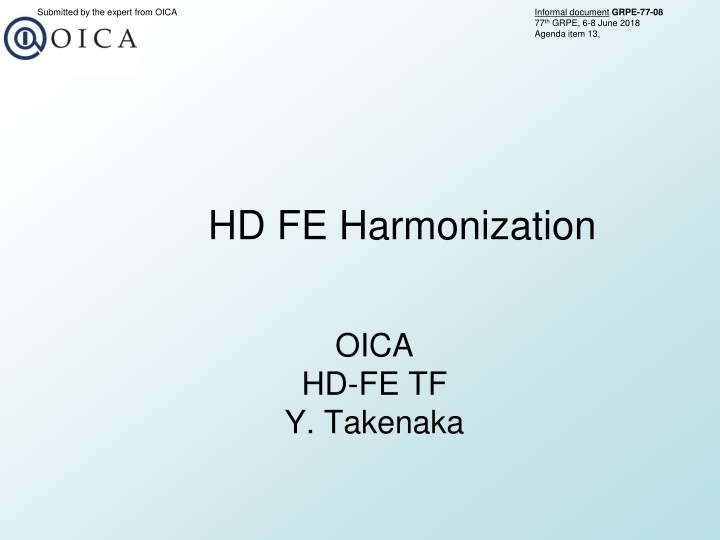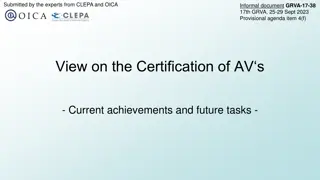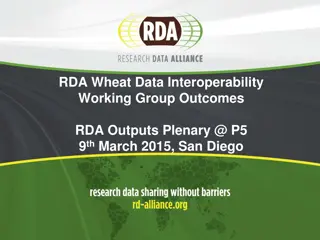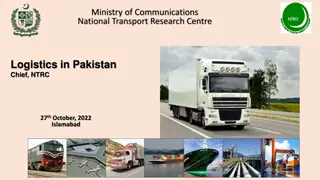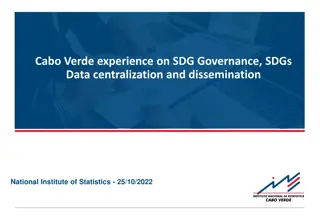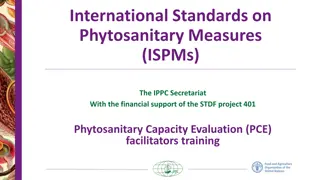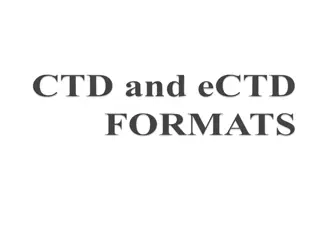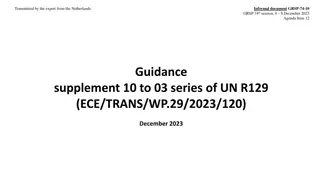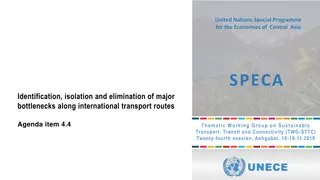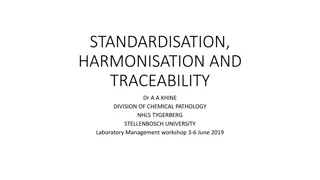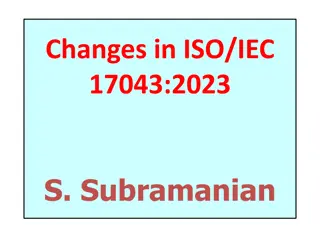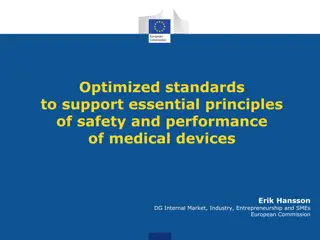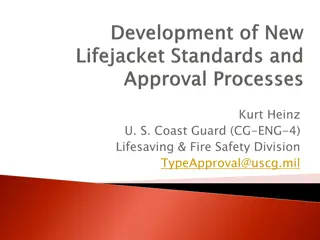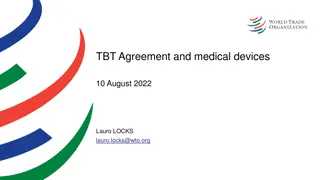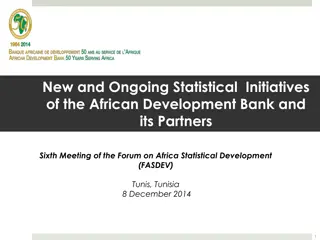HD FE Harmonization
This document outlines the regulatory schedule and measurement methods for fuel efficiency (FE) harmonization worldwide. It covers key elements of FE regulation, examples of measurement methods, and the status of FE elements in various regions. The content discusses criteria, considerations, and future developments in the field.
Download Presentation

Please find below an Image/Link to download the presentation.
The content on the website is provided AS IS for your information and personal use only. It may not be sold, licensed, or shared on other websites without obtaining consent from the author.If you encounter any issues during the download, it is possible that the publisher has removed the file from their server.
You are allowed to download the files provided on this website for personal or commercial use, subject to the condition that they are used lawfully. All files are the property of their respective owners.
The content on the website is provided AS IS for your information and personal use only. It may not be sold, licensed, or shared on other websites without obtaining consent from the author.
E N D
Presentation Transcript
Submitted by the expert from OICA Informal document GRPE-77-08 77thGRPE, 6-8 June 2018 Agenda item 13, HD FE Harmonization OICA HD-FE TF Y. Takenaka
HD FE regulatory schedule in each area Year '13 '14 '15 '16 '17 '18 '19 '20 '21 '26 22 23 24 25 27 28 29 30 2025 HD FE standard 2015 HD FE standard JPN GHG Phase I Phase II US FE Phase I Labeling of FE value EU 2025 target 2030 4th stage 2nd stage 3rd stage 1st stage CHNA 2nd Stage of constant speed test Phase 1 (EuroIV) Phase 2(BSIV) India Phase1 (EuroVI) Phase1 (BSVI) Legislation Under consideration 2
Example of FE Measurement There are 3 major pillars of a simulation based CO2 declaration method: Simulation tool, certified input data and representative boundary conditions. 3
Elements FE regulation including measurement method Elements Sub-Elements Issues Examples Transport efficiency or easily understand able unit - km/L - ton.km/L FE Unit - Limit of FE value or average value - Averaged by number of sales (CAFE) Others Criteria Simpler category is desired, but needs to reflect to real world complexity - Vehicle type (Tractor, bus .etc) - GVW, type of cabin Vehicle classification - Accuracy vs. cost of measurement Contribution for FE - Engine, T/M - Aero dynamic and rolling resistance Items of FE effect - Vehicle speed base or road data base less complexity vs real world reflection - Combination of two cycles - Unique mode for each vehicle type Driving Mode - Chassis dynamometer Chassis dynamometer measurement requires real vehicle - Common calculation logic - Difference of steady and transient Simulation Driver model is required for simulation Number of measurement points Transient operation effect - CO2 measurement by engine - Engine FE map and simulation Engine measurement Measurement Method Measurement methods Selection of vehicle type, rear body - Coast down, steady speed drive - CFD - Wind tunnel Aero dynamic measurement - Common tyre measurement method - How to handle a number of axis Tyre rolling resistance Measurement method, labeling 4 Measurement method - Driveline drag, Auxiliary drag, etc Others
FE Elements in each Area Status of each region US Phase Item Sub-item Japan (Next FES) EU China Weight Cab type Vehicle type Weight Vehicle type Weight Categorize Axles, Configurations, Weight CO2 g/ton-km g/passenger-km gal/1000ton-mile CO2 g/ton-mile FE Unit L/100km km/L FES value around 2025 is decided this year FE Criteria Consider after labeling Becomes strict every 3 years Becoming strict in 2019 ARB tangents 55,65 mph Mode 10type C-WHVC JE05, Inter city 70points for 55,65 mph Steady state Engine Map 100 points 81 points 51 points Cycle average map NA (Include chassis dyno) Engine Transient Engine Map NA NA NA (Include chassis dyno) Transient coefficient WHTC correction factor tool Include Cycle average map Table value 3% For Hybrid, AT, AMT by simulation For Hybrid, AT, AMT by powertrain test For Hybridand AMT by simulation Powertrain FE map with powertrain NA Table value or Measurement Table value or Measurement NA (Include chassis dyno) T/M efficiency Table value Table value or Measurement NA (Include chassis dyno) Table value or Measurement Measurem ent method Gear AT parts efficiency Include powertrain test method Table value or Measurement Table value or Measurement NA (Include chassis dyno) Axle efficiency Table value Coast down Wind tunnel CFD Table value (Opt. Wind tunnel or coast down) Constant speed Simulation Coast down or Constant speed Aero Drag measurement Aero Drag Vehicle select method Family Concept ? ? Family Concept (EC) 1222/2009 = ISO28580 Ranking by ISO28580 Resistance measurement ISO28580 Table value Tire Direct input of tire RRC for each vehicle Direct input of tire RRC for each vehicle Averaging tire RRC to be used Resistance select Method - Generic or OEM-specific Only installed when measuring engine auxiliary parts ? NA Simulation Input data & Logic Input data and driver model is different based on item above Determine FE value 5 Must family-representative vehicle Chassis dyno NA NA NA
HD FE regulatory schedule in each area Year '13 '14 '15 '16 '17 '18 '19 '20 '21 '26 22 23 24 25 27 28 29 30 2025 HD FE standard 2015 HD FE standard JPN GHG Phase I Phase II US FE Phase I Labeling of FE value EU 2025 target 2030 4th stage 2nd stage 3rd stage 1st stage CHNA 2nd Stage of constant speed test Phase 1 (EuroIV) Phase 2(BSIV) India Phase1 (EuroVI) Phase1 (BSVI) Possibility of Rule making Legislation Under consideration 6
Steps for Harmonization Elements Sub-Elements Issues Examples Transport efficiency or Easy to understand for everybody - km/L - ton.km/L FE Unit - Criteria Second step Limit of FE value or average value - Averaged by number of sales - CAF Others Simpler category is desired, but needs to reflect to real world compexity - Vehicle type (Tractor, bus .etc) - GVW, type of cabin Vehicle classification - Accuracy vs. cost of measurement Contribution for FE - Engine, T/M - Aero dynamic and rolling resistance Items of FE effect - Vehicle speed base or road data base less complexity vs real world reflection - Combination of two cycles - Unique mode for each vehicle type Driving Mode - Chassis dynamometer Should Chassis dynamometer measurement be used First step Should simulation be used Driver model contents - Common calculation logic - Difference of steady and transient Simulation Number of measurement points Transient operation effect - CO2 measurement by engine - Engine FE map and simulation Engine measurement Measurement Method Measurement methods Selection of vehicle type, rear body - Coast down, steady speed drive - CFD - Wind tunnel Aero dynamic measurement - Common tyre measurement method - How to handle a number of axis Tyre rolling resistance Measurement method, labeling 7 Measurement method - Driveline drag, Auxiliary drag, etc Others
Summary FE legislation is increased in these 10 years and will increase more in future. This is big burden for manufactures. Several rules are updated but not harmonized, rather sometimes unique rules are introduced based on each governmental policy. Simulation is adopted in each rule and exist 4 different software. It may increase in future. It seems each rule will be updated in near future. Several countries is planning to introduce FE legislation near future. Harmonize rule should be prepared as soon as possible not to miss the chance of harmonization. It is recommended to separate two steps for HD FE harmonization to be effective in short time. FE measurement GTR is recommended as 1st step. It is strongly recommended by OICA/GEPE that the WS to share the information on this matter and consider about suitable action in future will be organized in next GRPE. 8
Major Elements of FE Measurement Driving cycle Simulation Engine measurement Driving Resistnace 10
Key Elements of FE Measurement Driving Cycle Driving cycle defines the driving conditions to evaluate the fuel consumption. Two types of driving cycle are adopted in. A: Time and vehicle speed B: Distance and target speed Status of each region US Phase Item Remarks Japan (FES 2025) EU China B A A A B requires more realistic driver model Type Distance and target speed Time and speed Time and speed Time and speed Number of cycle types 10 4 3 2 Trucks:5 City Bus:3 Bus:2 ARB tangents 55 mph 65 mph Idle Above four kinds of weighting factor depending on the category of the vehicle. JE05 Inter city (80km/h) Although there are few types of cycles other than EU, weighting factor is changed for each vehicle category. C-WHVC Urban Suburban Highway Above three kinds of weighting factor depending on the category of the vehicle. Details of cycle Above two kinds of weighting factor depending on the category of the vehicle. 11
Key Elements of FE Measurement Simulation Simulation is introduced to evaluate HDV with fuel efficiency. Mathematical method of simulation seems similar for each software. Input data differs because of the difference of concept or FE items. Status of each region US/GEM Phase Classification Item Remarks Japan (FES2025) EU China /VECTO Vehicle Category Curb Weight Gross Vehicle Weight Maximum Payload Gross Combination Weight Rated Passenger Capacity Axle Configuration Axle Number Aero drag (Cd) Auxiliary Engine Fuel Full Load Engine Torque Motored Engine Torque Idling Speed Rated Engine Speed Maximum Engine Speed Transient Engine Map Transmission Number of gear Transmission gear ratio Transmission drag Final reduction gear ratio Drive axle drag Rolling radius Rolling resistance Vehicle Parameters * By spec. of technology * Map Engine Parameters type MT,AT,AMT Drive train Tire 12
Key Elements of FE Measurement Engine measurement FE map measured by steady state operation is commonly used to take account engine performance. However, US Phase II introduced new method called Cycle averaging map . Status of each region US Phase Item Remarks Japan (FES2025) EU China 70points for 55,65 mph Steady state Engine Map 100 points 81 points 51 points Difference in concept Cycle averaging map Transient Engine Map NA NA NA WHTC correction factor tool Include Cycle averaging map Transient coefficient NA Table value 3% Steady state Engine measurement Cycle averaging map fuel -consumption map 800 700 600 500 400 300 200 100 0 -100 -200 500 1000 1500 2000 2500 3000 13 Engine speed [rpm]
Key Elements of FE Measurement Driving Resistance There are two types of methods for measuring Aero Drag, Coast down test and Constant speed test . One of these or both is adopted in each area. Tire RRC measurement uses ISO 28580 which is a tire bench test method common to each region. Status of each region US Phase Item Sub-item Remarks Japan (FES2025) EU China Coast down Constant speed Coast down Similar method is used, but no common method Table value (Opt. Wind tunnel or coast down) Aero Drag Aero Drag measurement Wind tunnel Simulation Constant speed CFD Resistance measurement Method of measuring tire RRC is common in individual areas in the unit test by ISO method. (EC) 1222/2009 = ISO28580 ISO28580 Table value ISO28580 Tire RRC Direct input of tire RRC for each vehicle Direct input of tire RRC for each vehicle Resistance select Method Averaging RRC to be used - 14
